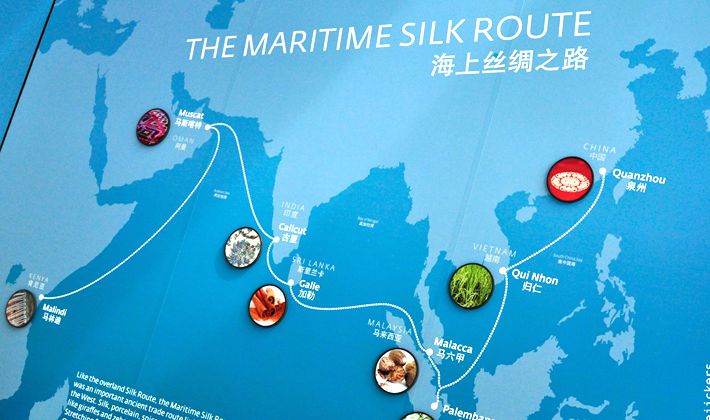China-NZ FTA would help drive the maritime silk road

Global Times | 2 December 2016
China-NZ FTA would help drive the maritime silk road
By Chen Xiaochen and Zhou Ximeng
New Zealand Prime Minister John Key said last week that China and New Zealand had agreed to launch talks to upgrade their free trade agreement (FTA). This would be the first time for China to upgrade an FTA with a Western country at a higher standard and the move marks great breakthroughs.
The total population of New Zealand is 4.64 million and the country’s GDP stands at $173.7 billion. Bilateral trade between China and New Zealand reached $11.5 billion in 2015, which is nothing in comparison to China’s trade volume with the EU, the US, Japan or Australia. So why do we call an upgraded agreement with New Zealand a breakthrough?
New Zealand has actually played a significant role in China’s drive to integrate with the world market and develop foreign trade. It was the first developed nation to sign a bilateral agreement with China upon China’s entry into the WTO and recognize China as a market economy. It was also the first developed country to start and complete bilateral FTA negotiations with China. Upgrading the FTA would again make New Zealand the first developed country to do so with China. Currently, China is New Zealand’s top export destination and largest source of imports.
New Zealand’s unique advantages mean that through the upgraded FTA, they will play a greater role in boosting global trade and investment and will help China gain a greater say in the world’s trade rules.
The upgraded FTA will create major breakthroughs in a number of ways.
First, it could lead to a breakthrough in negotiations for an Asia Pacific free trade zone. World trade growth has remained weak since the 2008 financial crisis and has even underperformed world economic growth. One reason is the complication of applying domestic trade rules on international agreements. The 2014 Asia-Pacific Economic Cooperation (APEC) summit in Beijing adopted a roadmap for a free trade zone in Asia Pacific and decided to study issues related to establishing an FTA in the region. The just-concluded APEC summit in Peru proposed to draft a work plan for establishing the Asia Pacific free trade zone. Talks of upgrading the FTA between China and New Zealand can lead the way toward establishing this FTA in Asia Pacific.
Negotiations for the upgraded FTA will also offer China the chance to learn about making a new generation of trade rules. Currently, China has FTAs with 14 countries and regions, contributing to the development of global free trade. But the current FTAs focus only on traditional trade. Trade agreements such as the Comprehensive Economic and Trade Agreement between Canada and the EU, the Trans-Pacific Partnership and the Trans-Atlantic Trade and Investment Partnership belong to the new generation of free trade pacts, focusing more on trade rules such as consolidating regulatory criteria in areas including tax equality, protection of labor rights and intellectual property right. These are areas China will need to engage in as it continues to develop its trade and investment.
The upgraded FTA could also lead the way for China to renegotiate with other developed nations. China has signed six FTAs with developed countries and is currently in negotiations with Norway. China is also negotiating with the US on a bilateral investment treaty and has shown willingness to embark on an FTA with the UK and the EU. The negotiations with New Zealand will offer valuable experience, wisdom and technical support for China as it engages with other developed nations in trade talks.
Meanwhile, negotiations for an upgraded FTA could help China familiarize itself with the business and legal systems in the UK and the US. Given historical and cultural reasons, New Zealand shares various similarities with the legal and business systems from the UK and the US. The FTA talks could help China accumulate experience and boost China’s capability in negotiating with the US and the UK over political and economic issues.
Lastly, the upgraded FTA with New Zealand could lead to breakthroughs in China’s drive to promote the "One Belt, One Road" initiative in the South Pacific. Despite China’s considerable progress in building the land route, progress in building a maritime "silk road," particularly toward the South Pacific is relatively slow. One reason is that China is less familiar with the South Pacific, which means there are less developed trade and economic engagements with the region. New Zealand would be a pivotal country along this maritime route, which has diplomatic ties with all other independent island countries in the South Pacific. The negotiations for an upgraded FTA could help China better understand the economic, trade and cultural bonds between New Zealand and other countries in the South Pacific and learn about the communication channels between them. This will help China build knowledge and gain third-party support as it pushes ahead with the maritime silk road in the South Pacific.
Chen Xiaochen is head of the Department of International Studies with the Chongyang Institute for Financial Studies at Renmin University of China, and Zhou Ximeng is a research intern at the Chongyang Institute. bizopinion@globaltimes.com.cn





